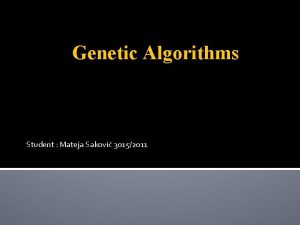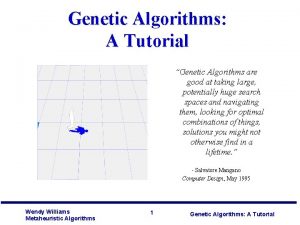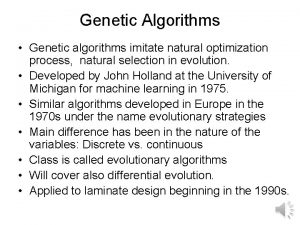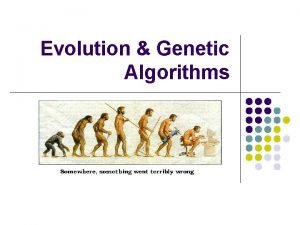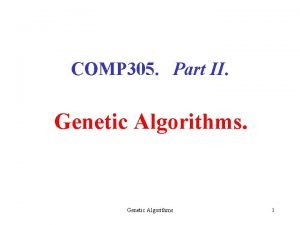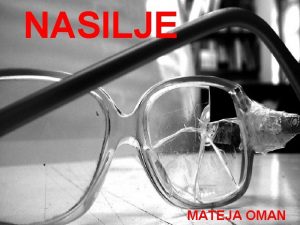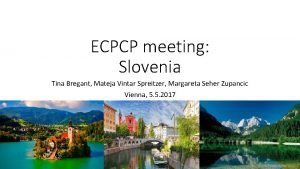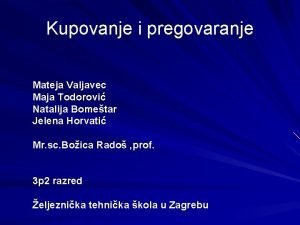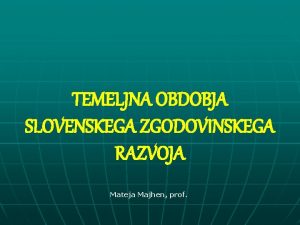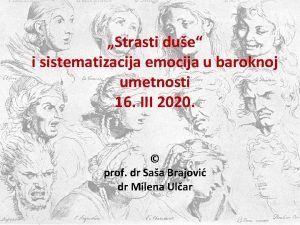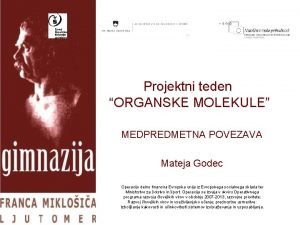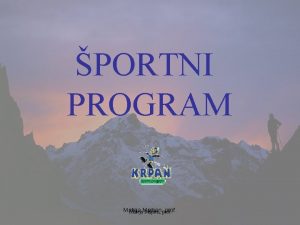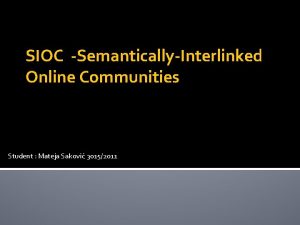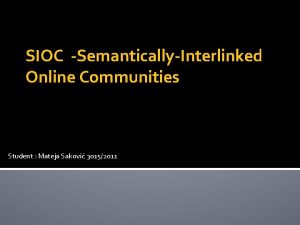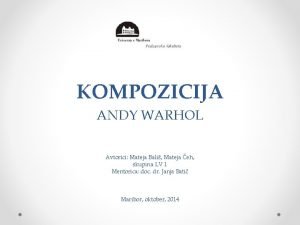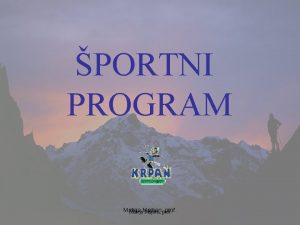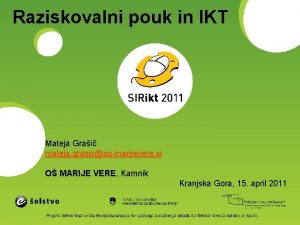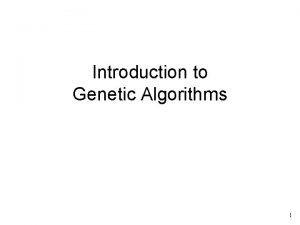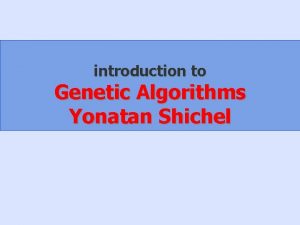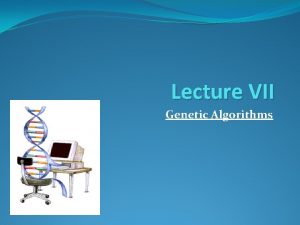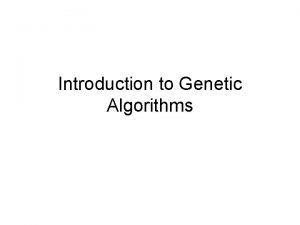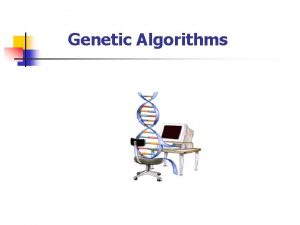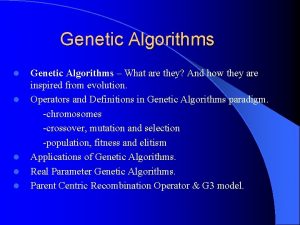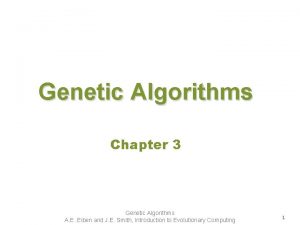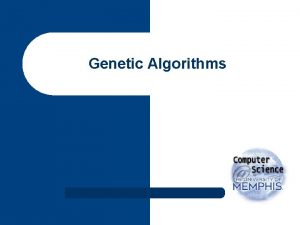Genetic Algorithms Student Mateja Sakovi 30152011 Introduction Genetic



















- Slides: 19

Genetic Algorithms Student : Mateja Saković 3015/2011

Introduction �Genetic algorithms are based on evolution and natural selection �Evolution is any change across successive generations in the heritable characteristics of biological populations �Natural selection is the nonrandom process by which biological traits become either more or less common in a population 2/19

Introduction(2) �Genetic algorithms apply the same idea to problems where the solution can be expressed as an optimal individual and the goal is to maximize the fitness of individuals �Genetic algorithms find application in bioinformatics, phylogenetics, computational science, engineering, economics, chemistry, manufacturing, mathematics, physics and other fields. 3/19

History � 1957 – Alex Fraser – simulation of evolution � 1960 – Rechenberg's group – solving complex engineering problems with evolutionary programming � 1967 - J. D. Bagley - term genetic algorithms � 1975 – John Holland – “Adaptation in Natural and Artificial Systems ” � 1980 – General electric – first GA product 4/19

Algorithm � 1. Identify the genome and fitness function � 2. Create an initial generation of genomes � 3. Modify the initial population by applying the operators of genetic algorithms � 4. Repeat Step 3 until the fitness of the population no longer improves �Genome is apopulation of strings which encode candidate solutions �Fitness function is a function that combines the parameters into a single value �Operators — selection, crossover and mutation 5/19

Initialization �Individual solutions are randomly generated to form an initial population (usually) �Solutions may be seeded in areas where optimal solutions are likely to be found (occasionally) �Population size depends on the nature of the problem 6/19

Operators �Selection keeps the size of the population constant but increases the fitness of the next generation. Genomes with a higher fitness proliferate and genomes with lower die off. �Crossover is a way of combining two genomes �Mutation makes an occasional random change to a random position in a genome 7/19

Selection �The chance of a genome surviving to the next generation is proportional to its fitness value �Size of the population remains constant � 1. The fitness function is evaluated for each individual, providing fitness values, which are then divided by the sum of all fitness values � 2. A random number R between 0 and 1 is chosen � 3. The selected individual is the first one whose accumulated normalized value is greater than R � 4. Repeat this procedure until there are enough selected individuals 8/19

Crossover �Creates two new genomes(children) from two existing ones �The first part of one genome swaps places with the first part of the second (genomes are divided in random position) � 1. Select pairs of genomes and flipping a coin to determine whether they split and swap. � 2. If they do crossover, then a random position is chosen and the children of the original genomes replace them in the next generation � 3. Repeat step 1 for all pairs of parents in population 9/19

Mutation �Miscoded genetic material being passed from a parent to a child �Mutation rate is quite small for GA, usually one mutation per generation �When a mutation occurs, the bit changes from a 0 to a 1 or from a 1 to a 0 �Helps avoid premature convergence to a local optimum 10/19

Example �Find maximum value of a function 31 p – p 2 with a single integer parameter p (0<=p<=31) �P is a string of 5 bit 11/19

Initialization – example �Four randomly generated genomes Genome P Fitness 10110 22 198 00011 3 84 00010 2 58 11001 25 150 12/19

Selection - example Genome Fitness % of total fitness copies 10110 198 40. 4% 1. 62 00011 84 17. 1% 0. 69 00010 58 11. 8% 0. 47 11001 150 13. 6% 1. 22 Selection Genome P Fitness 10110 22 198 11001 25 150 00010 2 58 10110 22 198 13/19

Crossover - example Crossover for 10110 and 00010 10|110 Genome P 18 00|010 10010 11001 25 00110 6 10010 10110 22 Fitness 234 150 198 14/19

Mutation - example Mutation in 11001 on position 3 11001 -> 11101 Genome P Fitness 10010 18 234 11101 29 58 00110 6 150 10110 22 198 15/19

Pros and cons Advantages : �Understandable �Can solve any problem which can be encoded �Easily distributed Disadvantages : �Expensive fitness function evaluations �Converge towards local optimum or even arbitrary points rather than the global optimum �GAs cannot effectively solve problems in which the only fitness measure is a single right/wrong measure 16/19

Improvements �Crowding – populaton grow in size (fast convergence) �DNA - two possible values for each gene, remembering a gene that was useful in another environment 17/19

Refrences �Michael J. A. Berry, Gordon S. Linoff “Data Mining Techniques For Marketing, Sales, and Customer Relationship Management”, 2004 �Wikipedia - http: //www. wikipedia. org/ 18/19

Thank you for attention! Questions? Mateja Saković 3015/2011 19/19
 Sakovi
Sakovi Genetic algorithms tutorial
Genetic algorithms tutorial Genetic algorithms
Genetic algorithms Genetic algorithms
Genetic algorithms Genetic algorithms
Genetic algorithms Founder population
Founder population Genetic programming vs genetic algorithm
Genetic programming vs genetic algorithm Genetic programming vs genetic algorithm
Genetic programming vs genetic algorithm What is gene flow and genetic drift
What is gene flow and genetic drift What is the difference between genetic drift and gene flow
What is the difference between genetic drift and gene flow Mateja oman
Mateja oman Bregant tina
Bregant tina Mateja savoie roskos
Mateja savoie roskos Mateja grizelj
Mateja grizelj Mateja i maja
Mateja i maja Mateja majhen
Mateja majhen Karavadjo pozivanje svetog mateja
Karavadjo pozivanje svetog mateja Mateja godec
Mateja godec Mateja majhen
Mateja majhen Mateja leskovar
Mateja leskovar
